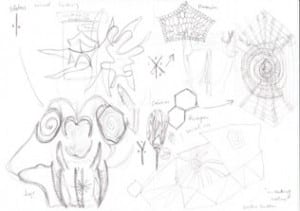Rearranging the natural world
By Dean W Veall, on 9 May 2013
Here at the Grant Museum we display our objects taxonomically (and have done since Grant founded the collection in 1828), objects are grouped together to reflect their evolutionary relationship to each other. This method of viewing the natural world has been with us since the Swedish naturalist Carl Linneaus introduced his work that classified the natural world, Systema naturalis, in the 18th Century. This method of classification has changed over time to reflect and accommodate current thinking in science, but primarily the principle has remained unchanged, grouping animals based on shared characteristics.
Artist researcher Gemma Anderson and a group of the public took another view of our collection based on her concept of Isomorphology.
Isomorphology
By Gemma Anderson
As an artist, my interest spans zoological, mineralogical and botanical collections I spend a lot of time drawing specimens and observing form – which has led to an awareness of the resemblances between species of separate kingdoms. As I work, I have become aware that there is no specific documentation of cross-kingdom resemblances between the animal, the vegetable and the mineral. With further thought, I have realized that behind these perceived resemblances are various geometric forms and symmetries. These form the basis of the concept of ‘Isomorphology’ – a new term which I have coined. It is derived from ‘Isomorphism’; a mathematical and biological concept.
Isomorphology is a comparative, drawing based method of enquiry into the shared forms of animal, mineral and vegetable morphologies. As a holistic and visual approach to classification, Isomorphology runs parallel to scientific practice while belonging to the domain of artistic creation. It is complementary to science, addressing relationships that are left out of the scientific classification of animal, vegetable and mineral morphologies.
Working with a group of 22 members of the public of various backgrounds from art students to mathematicians we explored Isomorphology in the context of the Grant Museum’s collections. I re-classified certain zoological specimens in the cabinets and mineral specimens on the tables into the visual categories of Isomorphology (Hexagonal, Five Fold symmetry
etc), I then invited participants to make drawings from these specimens. Afterwards we came to discuss the possibilities of joining different forms and symmetries together, to create a chimera joining zoological and mineral specimens, based on their shared forms and symmetries. This led to some amazing creations, salamander seahorses, coral tail bones, and zoological chimeras composed of countless anatomical features.
Sharing with the public my concept of Isomorphology and leading this workshop raised some interesting questions, from the visitors, for me to reflect on, here are a choice few.
‘Why draw the specimen when I could take a photograph?’
This led to discussions about observation, the value of spending time with specimens, and how the selective process of drawing emphasizes morphological features, and makes forms easier to compare with one another.
‘How did you start working with scientists?’
My own process of working with museums in London began in 2005, always motivated by drawing and observing new forms, and slowly building relationsh
ips with individual scientists and institutions. I believe that ideas and questions can take you anywhere, and through drawing you can learn about anything.
‘Why do these forms and symmetries re-occur across animal, mineral and vegetable species?’
There is no simple answer……some forms are efficient structures, some are the result of convergent evolution, some of genetics and chemistry. There are many ways to respond to this question, but all the explanations are partial, and many aspects remain mysterious (even to scientists).
Our session at the Museum ended by discussing the potential to think about observation as a creative way to engage with the natural world and to practice this approach, not only in the context of the museum, but on the street, in the park and the garden.
Note:
Gemma Anderson has been developing Isomorphology as a practice based PhD research project and creative educational model (www.isomorphology.com). She has been interested in the Grant Museums collections since she was an MA student at the Royal College of Art in 2005. Many of the specimens from the Grant Museum collections and UCL’s Geology collections appear in her work, most notably in the Wellcome Trust Arts Award project ‘Portraits: Patients and Psychiatrists’ 2010-2011 (www.gemma-anderson.co.uk/portraits).
Dean Veall is Learning Officer at the Grant Museum of Zoology
 Close
Close







